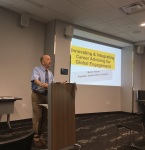Global Career Compass
Leveraging Education Abroad for Student Career Development & Employability
Tap Minority Serving Institutions to Increase Diversity in Study Abroad
I’m very pleased to have Dr. Gasman provide her insights on an issue which has bedeviled the international education field for decades. We have been well aware of the huge racial disparity among students who have the opportunity to study abroad – and despite the best intentions of both academic institutions and “provider” organizations, the numbers have only moved the needle of equality a tiny percent. But the new model partnership between the Penn Center and CIEE described here is promising.
If you also would like to place this issue in perspective, see this recent essay in The Hechinger Report on the higher ed “caste” system with respect to enrollment of low-income students: http://hechingerreport.org/fixing-a-higher-education-caste-system-that-screams-inequality-help-us-find-answ ers/
Guest post by Dr. Marybeth Gasman
Executive Director, Penn Center for Minority Serving Institutions
Professor of Higher Education
University of Pennsylvania
Seventy-six percent of college students studying abroad are White and of those, 65 percent are women. Given the educational and career advantages that students studying abroad have, these figures demonstrate the inequities in society and American higher education for students of color. However, there are ways to ensure more diversity among students studying abroad. One way is to work with Minority Serving Institutions (MSIs) to create opportunities.
There are roughly 600 federally designated MSIs throughout the nation and they educate 26% of all college students – a significant number. Of note, they educate half of all Latinos and nearly half of all Asian Americans and Pacific Islanders. Currently, only 3.6% of all students studying abroad hail from MSIs but that figure could be increased substantially. First, organizations focused on study abroad can partner with MSIs to make studying abroad easier, more affordable, and straightforward. Second, these same organizations can provide training for faculty and staff interested in leading study abroad experiences. Third, again, these same organizations can help to dispel myths around study abroad – around cost and safety – for MSI students and their parents. Many MSI students did not grow up traveling, are very close to their families, and come from low-income families. As such, dispelling myths is crucial to sending more MSI students and students of color in general abroad.
Over the past year, we at the Penn Center for Minority Serving Institutions have partnered with the Council on International Educational Exchange (CIEE) to create opportunities for MSIs. Our efforts speak to the Institute of International Education’s Generation Study Abroad initiative, which seeks to double the number of students going abroad. However, we are focused specifically on increasing the diversity of those students studying abroad. Most recently, we brought together a group of MSI presidents to discuss bold ideas for increasing participation among students of color in study abroad and how to make study abroad more feasible and accessible on their campuses. The partnership set several goals: 1.) To continue to bring MSI leaders together to explore bold ideas related to study abroad. For example, a study abroad program focused on STEM and held in conjunction with major tech company partners. 2.) To bring MSI provosts and faculty together to begin developing faculty-lead study abroad programs. 3.) To bring bold ideas, with multiple partners to CIEE for possible co-sponsorship.
This is just a start but we have more things planned in the coming years. Keeping our eyes on the inequities across opportunities in higher education is key to ensuring strong learning outcomes for all students.





